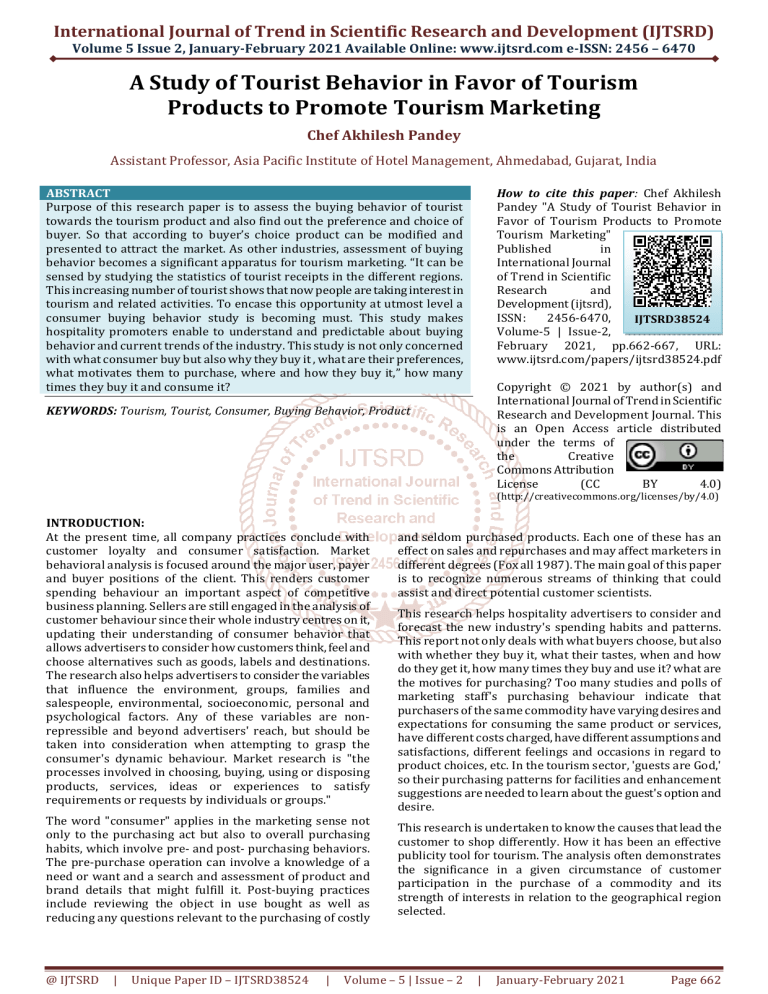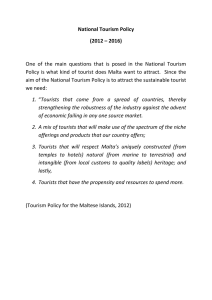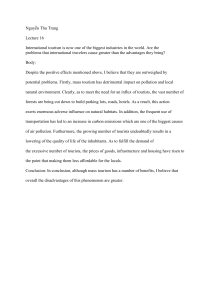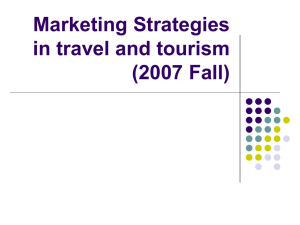
International Journal of Trend in Scientific Research and Development (IJTSRD)
Volume 5 Issue 2, January-February 2021 Available Online: www.ijtsrd.com e-ISSN: 2456 – 6470
A Study of Tourist Behavior in Favor of Tourism
Products to Promote Tourism Marketing
Chef Akhilesh Pandey
Assistant Professor, Asia Pacific Institute of Hotel Management, Ahmedabad, Gujarat, India
How to cite this paper: Chef Akhilesh
Pandey "A Study of Tourist Behavior in
Favor of Tourism Products to Promote
Tourism Marketing"
Published
in
International Journal
of Trend in Scientific
Research
and
Development (ijtsrd),
ISSN:
2456-6470,
IJTSRD38524
Volume-5 | Issue-2,
February 2021, pp.662-667, URL:
www.ijtsrd.com/papers/ijtsrd38524.pdf
ABSTRACT
Purpose of this research paper is to assess the buying behavior of tourist
towards the tourism product and also find out the preference and choice of
buyer. So that according to buyer’s choice product can be modified and
presented to attract the market. As other industries, assessment of buying
behavior becomes a significant apparatus for tourism marketing. “It can be
sensed by studying the statistics of tourist receipts in the different regions.
This increasing number of tourist shows that now people are taking interest in
tourism and related activities. To encase this opportunity at utmost level a
consumer buying behavior study is becoming must. This study makes
hospitality promoters enable to understand and predictable about buying
behavior and current trends of the industry. This study is not only concerned
with what consumer buy but also why they buy it , what are their preferences,
what motivates them to purchase, where and how they buy it,” how many
times they buy it and consume it?
Copyright © 2021 by author(s) and
International Journal of Trend in Scientific
Research and Development Journal. This
is an Open Access article distributed
under the terms of
the
Creative
Commons Attribution
License
(CC
BY
4.0)
KEYWORDS: Tourism, Tourist, Consumer, Buying Behavior, Product
(http://creativecommons.org/licenses/by/4.0)
INTRODUCTION:
At the present time, all company practices conclude with
customer loyalty and consumer satisfaction. Market
behavioral analysis is focused around the major user, payer
and buyer positions of the client. This renders customer
spending behaviour an important aspect of competitive
business planning. Sellers are still engaged in the analysis of
customer behaviour since their whole industry centres on it,
updating their understanding of consumer behavior that
allows advertisers to consider how customers think, feel and
choose alternatives such as goods, labels and destinations.
The research also helps advertisers to consider the variables
that influence the environment, groups, families and
salespeople, environmental, socioeconomic, personal and
psychological factors. Any of these variables are nonrepressible and beyond advertisers' reach, but should be
taken into consideration when attempting to grasp the
consumer's dynamic behaviour. Market research is "the
processes involved in choosing, buying, using or disposing
products, services, ideas or experiences to satisfy
requirements or requests by individuals or groups."
The word "consumer" applies in the marketing sense not
only to the purchasing act but also to overall purchasing
habits, which involve pre- and post- purchasing behaviors.
The pre-purchase operation can involve a knowledge of a
need or want and a search and assessment of product and
brand details that might fulfill it. Post-buying practices
include reviewing the object in use bought as well as
reducing any questions relevant to the purchasing of costly
@ IJTSRD
|
Unique Paper ID – IJTSRD38524
|
and seldom purchased products. Each one of these has an
effect on sales and repurchases and may affect marketers in
different degrees (Fox all 1987). The main goal of this paper
is to recognize numerous streams of thinking that could
assist and direct potential customer scientists.
This research helps hospitality advertisers to consider and
forecast the new industry's spending habits and patterns.
This report not only deals with what buyers choose, but also
with whether they buy it, what their tastes, when and how
do they get it, how many times they buy and use it? what are
the motives for purchasing? Too many studies and polls of
marketing staff's purchasing behaviour indicate that
purchasers of the same commodity have varying desires and
expectations for consuming the same product or services,
have different costs charged, have different assumptions and
satisfactions, different feelings and occasions in regard to
product choices, etc. In the tourism sector, 'guests are God,'
so their purchasing patterns for facilities and enhancement
suggestions are needed to learn about the guest's option and
desire.
This research is undertaken to know the causes that lead the
customer to shop differently. How it has been an effective
publicity tool for tourism. The analysis often demonstrates
the significance in a given circumstance of customer
participation in the purchase of a commodity and its
strength of interests in relation to the geographical region
selected.
Volume – 5 | Issue – 2
|
January-February 2021
Page 662
International Journal of Trend in Scientific Research and Development (IJTSRD) @ www.ijtsrd.com eISSN: 2456-6470
OBJECTIVE OF THE STUDY
To analyze buying behavior of the national tourist while
selecting tourism product.
To analyze buying behavior of the international tourist while
selecting tourism product.
To compare buying behavior of national and international
tourist while selecting tourism product.
To suggest the ways by which tourism products can be used
as apparatus for tourism marketing.
To find out the difference between male and female
respondent’s buying behavior.
REVIEW OF LITERATURE
Many surveys were performed on customer purchasing
efficiency by promotions or management employees, but
there is very little in relation to the tourism industry. Such
research which are as following are analyzed to explain
customer purchasing behaviour:
Many scholars identified various determinants of activity
purchasing by tourists but the key determinant of tourist
behaviour is motivation. The philosophy of inspiration came
into being because of the idea of need. It is crucial to
consider what people desire and how they can be met in
order to understand human motivation. In 1943, Maslow
was the first to pursue his own requires hypothesis, perhaps
the most established of all the theories of inspiration. Mill
and Morrison (1985), seeing travel as a need or as an urge to
please oneself, demonstrate how Maslow's vocabulary is
connected to travel and literature. Likewise, Dann (1977)
may be related to the need list of Maslow. He thought that
two considerations, the pull factors and the push factors are
ultimately an option for travel. The pull factors are the ones
influencing where you're going and the drive factors
Following the deciding need, the next aspect is how and from
which sources people wish to reach. A few empirical
experiments have tested human beliefs in order to evaluate a
specific destination for the sake of customers. Muller (1991)
says that in order to illustrate the utility of the profile of the
tourist segments, he established profiles for various sectors
in a foreign tourism industry such that different
requirements for the tourism destinations may be assigned
to unique guidelines of importance. Furthermore, “he
claimed that useful data is more available than profiles for
lifestyle, since a value survey is much shorter than a
questionnaire for a lifestyle. The strategy was to: consumer
categories isolating tourists from different characteristics of
a cities visit and to assess the marketing effect of the value
profiles on tourism product creation and promotional
strategies.” The visitors are significant in the development of
the market segments of this field.
The option of destination is conceptualized into two generic
stages, while Crompton specifies in the second process
(1977). The generic process poses the basic question
whether to take a break or not. The second phase is the
second stage while the decision-making procedure is done
for holiday, such as the destination schedule. In 1990, Um
and Crompton, on the other side, have looked at a concept to
examine the second stage with the creation of a framework
@ IJTSRD
|
Unique Paper ID – IJTSRD38524
|
for customers to select a destination. The definitions in the
sense were, in reality, external inputs, internal inputs and
cognitive buildings. The description of the social contacts
and marketing messages uncovered by the potential visitor
and the internal inputs perceived as a potential tourist who
involves personal resources, motivations, beliefs and
attitudes. For the new one of cognitive structures, the input
in the destinations and the induction range are mixed
internally and externally.
As an analysis in 2003's tourism papers, tourism activity has
dropped drastically within the fundamental segments of
consumption inquiry, destination, picture or decisionmaking. The secret to the reported studies was an
appreciation of the underlying motivation for picking goals
from different markets. The attitudes of urban citizens
towards tourism growth on Crete have been investigated by
Andriotis and Vaughan (2003). Holden (2003) established
Trekkers understanding of Nepal while motivations for
backpackers in Northern Australia Mohsin and Ryan (2003)
investigated. Uriely et al. (2003) explored the effect on their
attitudes to heritage tourism in Israel by the religious
attitudes of people. The explanations for cruise passengers
from a racial viewpoint, analyzed by Teye and Leclerc
(2003).
Following the analysis of the literature the impact factor and
tourism behaviour have been thoroughly studied, but a lack
remains in which a comprehensive examination of customer
behavior and its role in economic and infrastructural growth
and development is still important. However, the analysis
indicates that customer behaviour in the hospitality industry
is indeed positive as this industry may in the immediate
future become conscious of the taste and desires of
customers.
RESEARCH METHODOLOGY
Research Methodology Primary study has been undertaken
to determine customer shopping habits for different tourism
items. In order to know the degree of relevance of this
research to marketers, the secondary data were also
gathered.
Sample Size for the study the sample size was 250 numbers
of personnel was taken, it includes national and
international tourists. “Further the sample was divided into
two sub samples 150-100 from national and international
tourists respectively.”
Sampling Method: Convenience sampling method was used.
Sample Frame: Different age groups- 20-50 years from
different regions
Geographical Scope of the study is Udaipur city only.
For this study structured Questionnaire was used as a
Research instrument.
Statistical Tools: For the data analysis and interpretation
percentage analysis was used.
Analysis and Interpretation
After conducting the research and analysis of available data,
the findings which came out are as follows Rank your
priorities while selecting the tourist destination
Volume – 5 | Issue – 2
|
January-February 2021
Page 663
International Journal of Trend in Scientific Research and Development (IJTSRD) @ www.ijtsrd.com eISSN: 2456-6470
Table 1
National
I. Accommodation
28%
II. Transport
17%
III. Attraction
47%
IV. Shopping Centre and other facilities
8%
International
10%
20%
54%
16%
Male
16%
30%
37%
17%
Female
22%
24%
24%
30%
From the collected responses it is found that national tourists give I, II, III and IV priorities respectively to the attraction,
accommodation, transport and shopping centers and other facilities while they select the destination for travel.
Other side international tourists give I, II, III and IV priorities respectively to the attraction, transport, shopping centers and
other facilities and accommodation while they select the destination for travel.
After the comparison between national and international tourist’s collected responses it is found that they both give the first
priority to the attractions but after that there is variation among priorities between both types of tourists.
Why do you usually travel?
I. Leisure
II. Business
III. Meeting Friends and Relatives
IV. Other
Table 2
National
30 %
23 %
35 %
12%
International
65%
21 %
5%
9%
Male
40%
35%
15%
10%
Female
45%
12%
32%
11%
From the collected responses it is found that national tourist give I, II, III and IV ranks to the reasons of travel respectively to
the meeting friends and relatives, leisure, business and others.
From the collected responses it is found that international tourist give I, II, III and IV ranks to the reasons of travel respectively
to the leisure, business, others and meeting friends and relatives.
After the comparison between national and international tourist’s responses it is found that national tourists gave the major
reason for travelling is meeting friends and relatives whereas international tourist gave the major reason for travelling is for
leisure purpose.
Your opinion about a tour combining different well-known and less-known destinations could be
I. More Interesting
II. Interesting
III. Less Interesting
IV. Can’t Say
V. Risky
Table 3
National International
18%
35%
30.5%
32%
26%
7%
10.5%
12%
15%
14%
Male
35%
32%
13 %
7%
13%
Female
18%
31%
20%
15%
16%
From the collected responses it is found that national tourists majorly believes that combination of well-known and less known
destinations in itinerary will be interesting.
From the collected responses it is found that international tourists majorly believes that combination of well-known and less
known destinations in itinerary will be more interesting.
Rank your interests in selecting a tour destination.
Table 4
National
I. Adventure
18%
II. Night Life
15%
III. Culture
10%
IV. Health
5.5%
V. Nature
22%
VI. Rest
17%
VII. Visiting places seen on TV/ Movie
12.5%
International
25%
10%
20%
15%
14%
12%
4%
Male
26%
13%
13%
8%
16%
18%
6%
Female
17%
12%
17%
12.5%
20%
11%
10.5%
According to the received data national tourists are more interested to see the natural places than adventure activities.
According to the received data international tourists are more interested in adventure activities than culture.
Most challenging problems that you have face when you choose a destination
@ IJTSRD
|
Unique Paper ID – IJTSRD38524
|
Volume – 5 | Issue – 2
|
January-February 2021
Page 664
International Journal of Trend in Scientific Research and Development (IJTSRD) @ www.ijtsrd.com eISSN: 2456-6470
Table 5
National International
25%
34%
10%
21%
15%
20%
42%
20%
8%
5%
I. Quality of service
II. Reliability
III. Language Difficulties
IV. Price
V. Others--------------------
Male
30%
16%
15%
35%
4%
Female
29%
15%
20%
27%
9%
According to the received data for the national tourists most challenging problem is price than quality of service at the time of
the selection of destination.
According to the received data for the international tourists most challenging problem is quality of service than reliability at the
time of the selection of destination.
Give the preference for company on tour
I. Group
II. Social Group
III. Friends
IV. Couple
V. Individual
National
35%
7.5%
25%
23%
9.5%
Table 6
International
20%
10%
21%
24%
25%
Male
30%
5%
25%
20%
20%
Female
25%
12.5%
21%
27%
14.5%
As per the responses it is found that national tourists prefer the travel with group than friends.
As per the responses it is found that international tourists prefer the individual travel than as couple.
Kind of accommodation you would like to choose
Table 7
National International
I. Hotel
39.5%
50.5%
II. Camp Site
19.5%
10%
III. Guest House
27%
14.5%
IV. Private Apartment
14%
25%
Male Female
40% 50%
20% 9.5%
15% 26.5%
25% 14%
According to the received data it is found that the national tourists like to choose hotel as an accommodation than guest houses
at the travelling destination.
According to the received data it is found that the international tourists like to choose hotel as an accommodation than private
apartments at the travelling destination.
A medium you generally book your accommodation
By travel agency/ Tour Operator
Through the internet (other)
Directly at the hotel
Other: .........................................
Table 8
National
32%
21%
35%
12%
International
40%
35%
15%
10%
Male
40%
30%
25%
5%
Female
32%
26%
25%
17%
As per the responses it is found that national tourists prefer to book their accommodation directly to the hotel than through
travel agency
As per the responses it is found that international tourists prefer to book their accommodation through travel agency than
internet.
Rate the factors which affect your decision utmost to choose accommodation
Table 9
Infrastructure
Behavior and professionalism of the staff and owners.
Ambiance and facilities available
Location
National
21%
25%
43%
11%
International
18%
22%
35%
25%
Male
20%
23%
40%
17%
Female
19%
24%
38%
19%
According to the received data it is found that the national tourists gave highest rate to ambiance and facilities factor which
affect their decision at utmost level to choose accommodation than behavior and professionalism of the staff.
According to the received data it is found that the national tourists gave highest rate to ambiance and facilities factor which
affect their decision at utmost level to choose accommodation than location.
Your priority for long distance travel as mode of transportation
@ IJTSRD
|
Unique Paper ID – IJTSRD38524
|
Volume – 5 | Issue – 2
|
January-February 2021
Page 665
International Journal of Trend in Scientific Research and Development (IJTSRD) @ www.ijtsrd.com eISSN: 2456-6470
Table 10
National International
15%
40%
20%
15%
45%
25%
17%
10%
3%
10%
I. Flight
II. Own car / On Rent Car
III. Train
IV. Bus / Coach
V. Cruise/ Other
Male
35%
22%
20%
17%
6%
Female
20%
13%
50%
10%
7%
As per the responses it is found that travel by train for long distance journey is the first priority of the national tourists than
own/ rent car.
As per the responses it is found that travel by flight for long distance journey is the first priority of the international tourists
than train.
Choice of transport for sightseeing and nearby places
Table 11
National
I. Rental car
15%
II. Taxi/Auto
35%
III. Rental motorbike
15%
IV. Public transportation (bus)/ Local trains
20%
V. Excursion coach
15%
International
35%
17%
13%
10%
25%
Male
26%
22%
20%
14%
18%
Female
24%
30%
8%
16%
22%
According to the received data it is found that the national tourists majorly choose the taxi / auto for sight-seeing and visiting
nearby places than public transportation.
According to the received data it is found that the international tourists majorly choose the rent a car services for sight-seeing
and visiting nearby places than excursion coach.
Your most preferable plan at the time of booking an accommodation
Table 12
I. EP – European Plan (Only Room)
II. CP – Continental Plan (Room+ BF)
III. MAP – Modified American Plan (Room +BF + Lunch/Dinner)
IV. AP – American Plan (R+ BF+L+D) Full Board
National
15%
30%
45%
10%
International
5%
35%
50%
10%
Male
15%
30%
45%
10%
Female
5%
35%
50%
10%
According to the received data it is found that the national tourists prefer to take MAP plan at the time of booking the
accommodation than CP.
According to the received data it is found that the international tourists prefer to take MAP plan at the time of booking the
accommodation than CP.
What attraction allures you the most to visit the travel destination?
I. Gardens
II. Natural Beauty
III. Snow at Hill Station & Sports
IV. Shopping Places
V. Museum & Historical Places
VI. Theme Resorts
VII. Culture
Table 13
National International
7%
8%
35%
10%
25%
12%
10%
15%
5%
20%
10%
13%
8%
22%
Male
5%
23%
20%
10%
15%
12%
15%
Female
10%
22%
17%
15%
10%
11%
15%
As per the responses it is found that the natural beauty is the most alluring product of the tourism to travel the destination than
hill stations and sports for national tourists.
As per the responses it is found that the culture is the most alluring product of the tourism for international tourist than
museum and historical places.
How much you are willing to pay more for well planned and comfortable trip
20-30%
15-20%
10-15%
10%
Less than 10%
@ IJTSRD
|
Unique Paper ID – IJTSRD38524
Table 14
National International
10%
22%
17%
24%
25%
37%
40%
12%
8%
5%
|
Volume – 5 | Issue – 2
Male
20%
20%
30%
25%
5%
|
Female
12%
21%
32%
27%
8%
January-February 2021
Page 666
International Journal of Trend in Scientific Research and Development (IJTSRD) @ www.ijtsrd.com eISSN: 2456-6470
National tourist can pay 10% more from their travel budget for well planned and comfortable trip than 10-15%.
International tourists are willing to pay 10-15% more from their travel budget for well planned and comfortable trip than 1520%.
Is consumer buying behavior study is useful in tourism marketing?
Responses
Yes
No
Can’t Say
Table 16
Dealers (Tourism) Professionals (Tourism)
70%
65%
25%
15%
5%
20%
Tourists
45%
25%
30%
Figure 1
CONCLUSIONS
We can conclude by saying that the above mentioned
objectives are fulfilled and analyzed. All the factors and
variables taken in the study are clearly showing the buying
behavior of the national and international tourist. It is found
that there is a difference between both types of tourist in the
choice, selection criterion and consideration regarding
tourism product. There is the difference between male and
female respondent’s buying behavior also.
There is no doubt to say that consumer buying behavior
study is equally important in the tourism sector. Because it is
the only way by which marketers can get the information
regarding consumer’s purchase pattern, need, desire,
expectation and feedback. This study guides them to modify
their product according to the need and also motivate to put
innovation and creativity in product. “So, to know the
consumer’s taste, to predict the future trends of the industry
and for continuous up -gradation and to meet the demand of
the market, consumer buying behavior study become a
significant” apparatus for the tourism marketing.
SUGGESTIONS
To capture the market by Indian tourism sector it can be
suggested that there is a need to reduce the reliability gap in
the service.
To enhance the focus on infrastructural and technological
development
LIMITATIONS
The data which has been used in this study is limited and
area is also limited. It can be done on large scale. Few
variable and factors are considered, a detail study can be
done.
REFERENCES
[1] Holden, E (2004). Ecological footprints and
sustainable urban form. Journal of Housing and the
@ IJTSRD
|
Unique Paper ID – IJTSRD38524
|
[2]
[3]
[4]
[5]
[6]
[7]
[8]
[9]
[10]
[11]
[12]
[13]
Built Environment, p. 19, 91-109
Andriotis, K. & Vaughan, R.D. (2003). Urban residents’
attitudes toward tourism development: The case of
Crete. Journal of Travel Research, p. 42,172-185
Mill & Morrisn (1985). Socioeconomic variables and
their effect on tourism. Tourism system: an
introductory text, Englewood Cliffs, N.J. : Prentice-Hall
International, ISBN – 0139257691,– pp 52
Dann (1981). Tourist motivation: an appraisal, annals
of tourism research, p. 8:187-219
Um, S. and Crompton (1990). Attitude determinants
in tourism destination choice. Annals of Tourism
research, 17 (3), p.432-448
Muller (1991). Motivation of tourist, Consumer
behavior in travel and Tourism. The Haworth
Hospitality Press, NY, p.79-104
Mohsin, A. and Ryan, C. (2003). Backpackers in the
Northern Territory of Australia – Motives, behavior
and Satisfaction. International journal of tourism
Research, vol.5(2), p.113-131
Solomon, M.R. (1983), “The World of Products as
Social Stimuli: A Symbolic Interactionism
Perspective”, Journal of Consumer Research, 10,
December, pp. 319-329
Foxall and Madden, T.J. (1985), “A Closer Look at
Classical Conditioning”, Journal of Consumer
Research, 12, December, pp. 301- 315.
Anderson, P.F. (1983), “Marketing, scientific progress
and scientific method”, Journal of Marketing, 47, pp.
18-31.
http://www.slideshare.net/IBEFIndia/tourism-andhopitality-august-2013 retrieved on 12/12/14
http://www.hospitalityindia.com/hospitality-industryin-india.htm retrieved on 13/01/15
http://iosrjournals.org/iosr-jbm/papers/ncibpptevolume-1/1014.pdf retrieved on 18/01/15
Volume – 5 | Issue – 2
|
January-February 2021
Page 667






